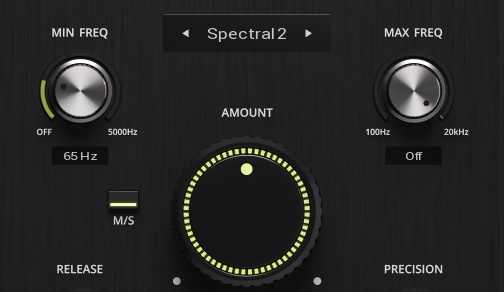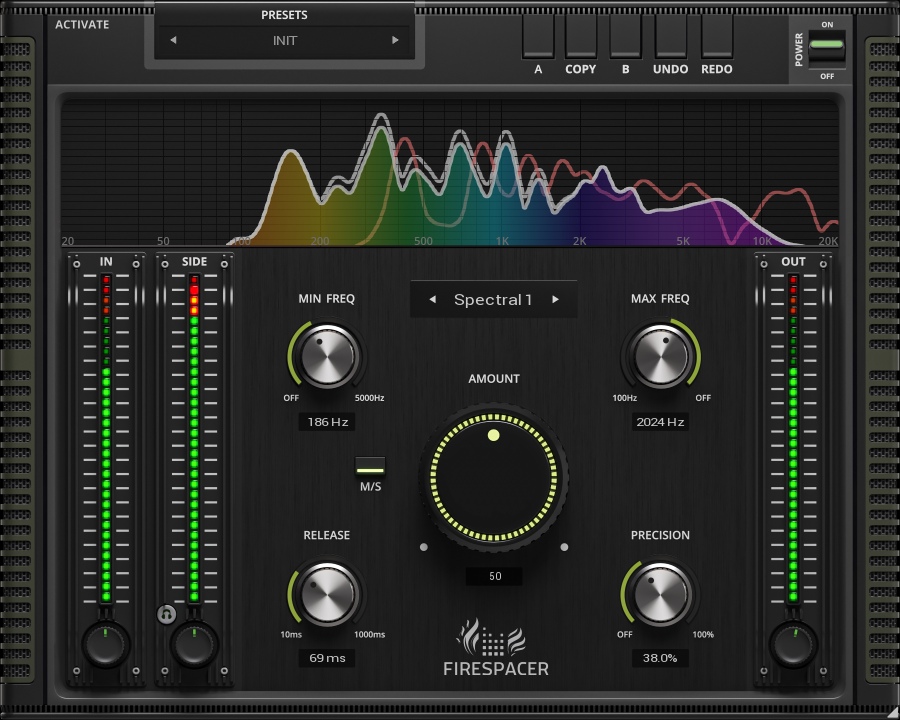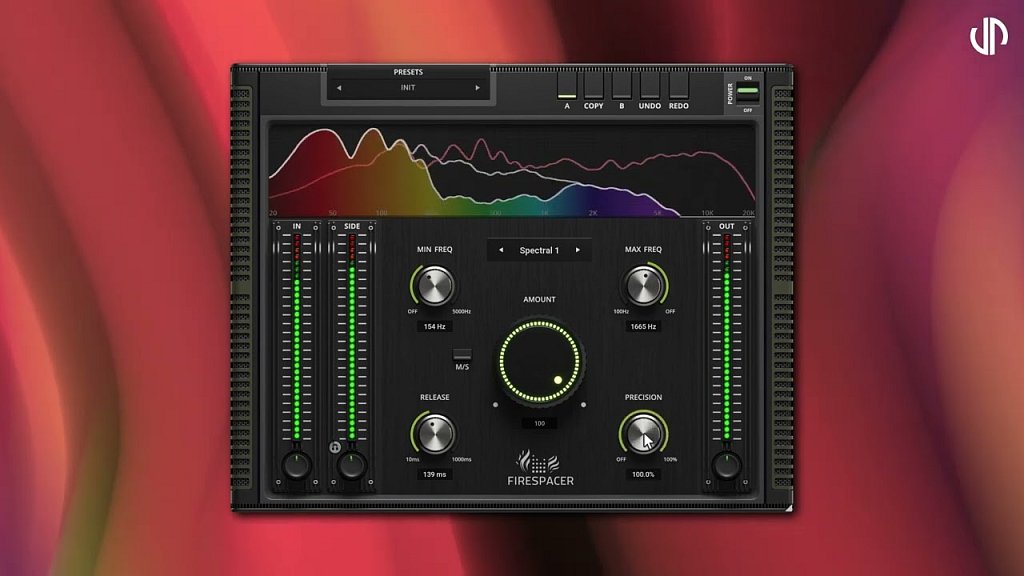FireSpacer Manual
Download PDF
Before you dive into reading, consider watching the walkthrough video first:
Amount controls how much the plugin removes colliding frequencies from the main input. The higher you set this, the better the input will be separated from the source at the expense of making it "miss" some frequencies. 50% usually serves as a good compromise.

Mode selects the algorithm to be used. The plugin provides 4 of them, each sounding different. Spectral algorithms are much more accurate, but they exhibit latency and possibly require more CPU power. No latency algorithms are cheaper, but they use minimum phase filters, which have much broader effect, hence they are less accurate and likely to remove more frequencies, which don't need removal.
Min Frequency controls the minimum frequency to be processed. All frequencies below this one won't be considered. It is useful if you want to limit the spectrum range to be affected. For example, if the vocal collides with a guitar, and full processing removes the guitar content to an extent at which the guitar doesn't sound as guitar anymore or is too silent, you may decide to increase this value to make sure the lower frequencies (fundamentals) of the guitar tones stay unaffected while still providing more room for the vocals by removing the higher frequency content.
Max Frequency controls the maximum frequency be processed. All frequencies above this one won't be considered. It is useful if you want to limit the spectrum range to be affected. For example, when solving collisions between bass and kick drum, removing bass content may be difficult since the initial slap of the kick may contain all frequencies, virtually removing the entire bass for a moment. In that case, you may lower this value to, say, 150Hz so that the plugin removes low frequencies of the bass but keeps the higher harmonics so that the listener can still hear the pitch.

Release controls how quickly the attenuated frequencies increase the level when they stop colliding anymore. The higher the value is, the less transparent but more effective at collision removal the plugin becomes.
Precision is useful only for spectral modes and controls how precise the plugin is at targeting the colliding frequencies. Maximum accuracy removes only frequencies that are nearly identical. That is most transparent, but less efficient. Conversely minimum accuracy removes even frequencies, which are further from each other.
M/S switch activates mid/side mode instead of the default left/right (or mono) mode.
Gain In controls the level change of the main input. Ideally, the inputs should be close to 0dBFS. Since this is a digital domain, exceeding 0dB is not a problem.
Side Gain controls the level change of the side-chain input. Ideally, the inputs should be close to 0dBFS. Since this is a digital domain, exceeding 0dB is not a problem.
Gain Out controls the level change of the output.
The Side-chain Listen switch lets you audition the side-chain only to make sure the correct track has been routed here.
FireSpacer Analyzer
Each of the curves of the analyzer shows the state of your audio signals in real-time. The grey line is your track's input signal, the rainbow-filled is the reduced output signal. Red represents the side-chain input.

FireSpacer Toolbar
FireSpacer features several standard controls, which can improve your workflow.

A, B and Copy buttons - The plugin remembers two sets of settings, A and B. Clicking any of these two buttons switches between these two settings. The selected one is highlighted in red. This is a great way for A/B checking and selecting the best settings. The "Copy" button copies the current settings to the other slot (if A is currently selected, the button will copy the current settings to slot B).
Presets and right and left arrows - The plugin comes with a set of presets, which should do the trick for most cases. Access them using the right and left arrows or by clicking the preset field directly. There, you can save and manage your own presets as well. On your computer, presets are stored in the following paths:
Windows:
C:\Users\username\Documents\FireSonic\FireSpacer
Mac OS X:
HOME/Documents/FireSonic/FireSpacer
Undo and Redo buttons - All of us make a mistake from time to time, which is when these two buttons come in handy. Undo button reverts your last change, Redo puts it back.
Bypass button - It is always a good idea to check if the plugin actually improves your sound, which is what the bypass button is for. In many DAWs it will be in sync with the DAW's bypass button (if it has one).
Right-Click menu
Right-click anywhere in the plugin background with the right mouse button, and you will get access to the following features.
Scale GUI precisely by percentage.
Get the version info.
Access product web page, reach support and access online documentation.
Contact support
Open the presets folder (to add, arrange or delete presets manually)
Activate/Deactivate the plugin
Access Licence Manager (to activate or deactivate the plugin or several plugins at the same time)
Disable/Enable GPU Acceleration.
Disable/Enable Intelligent sleep on silence function that disables the plugin when no sound is on input or output to save the CPU power.
Right-click any control (knob, button) to access help for the particular parameter.
Double-click Menu
Some parameters let you access more accurate numeric settings by double-clicking the knobs.
Installation and maintenance
Installation is a quick and simple process involving downloading and using a standard installer on both platforms, Windows and Mac OS X. The installer places the plugins and presets in proper locations so that your DAW can easily find them. The plugin is available for all relevant interfaces: VST, VST3, AAX, and AU. Note that on OS X, since High Sierra, you may need to restart your computer to make your DAW find new plugins.
If you are having trouble, please contact us at support@unitedplugins.com .
Updating
Updating the plugin to the newest version is as simple as using the newest installer.
Uninstallation on Windows
You can either use the link to the uninstaller in the start menu by typing FireSpacer for example or it can be accessed via Control panels / Applications /
Uninstallation on Mac OS X
First, delete the plugin files manually from:
AU: /Library/Audio/Plug-Ins/Components
VST: /Library/Audio/Plug-Ins/VST
VST: /Library/Audio/Plug-Ins/VST3
AAX: /Library/Application Support/Avid/Audio/Plug-Ins
Then if you really want to get rid of all data created by the plugin, remove the following folders as well:
HOME/Documents/FireSonic/FireSpacer
HOME/Library/Application support/FireSonic/FireSpacer
Note: Since OS X 10.7 (Lion), many folders are marked as hidden by default. To make them visible again in Finder, please follow this tutorial.
Trial and activation
Initially, FireSpacer is in demo mode. That lets you evaluate the plugin, try it in your mixing/mastering sessions and make sure it really does the trick. When ready, purchase a license from our shop (by clicking on the FireSpacer logo in the middle) or any of our resellers. You will receive a so-called license file, which you download to your computer. The plugin displays an ACTIVATE button when in trial mode, so click on it and select the license file. The plugin will check the license and activate it on your computer. After you restart your DAW, the plugin will be activated and will work indefinitely without restrictions. You can use the plugin on all your computers.
Support
Now that you’ve taken the time to learn all about FireSpacer enjoy and make your sound awesome! If our plug-ins helped you take your production to the next level, let us know, we’d love to hear from you and what you were able to create with our software.
If you encounter any problems, we offer free technical support for all registered users. Start with the frequently asked questions.
If you need further assistance, you can reach out to our Customer Support.
You can also reach our support staff by e-mail at:
support@unitedplugins.com


